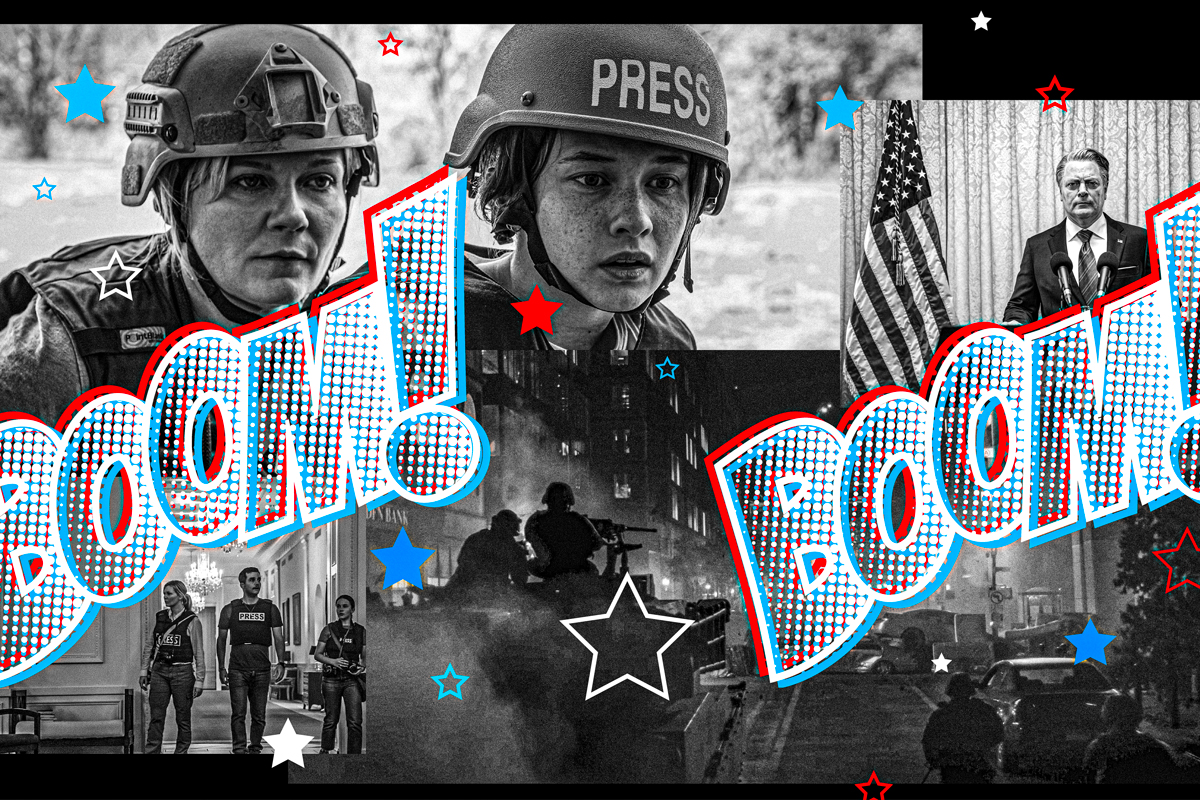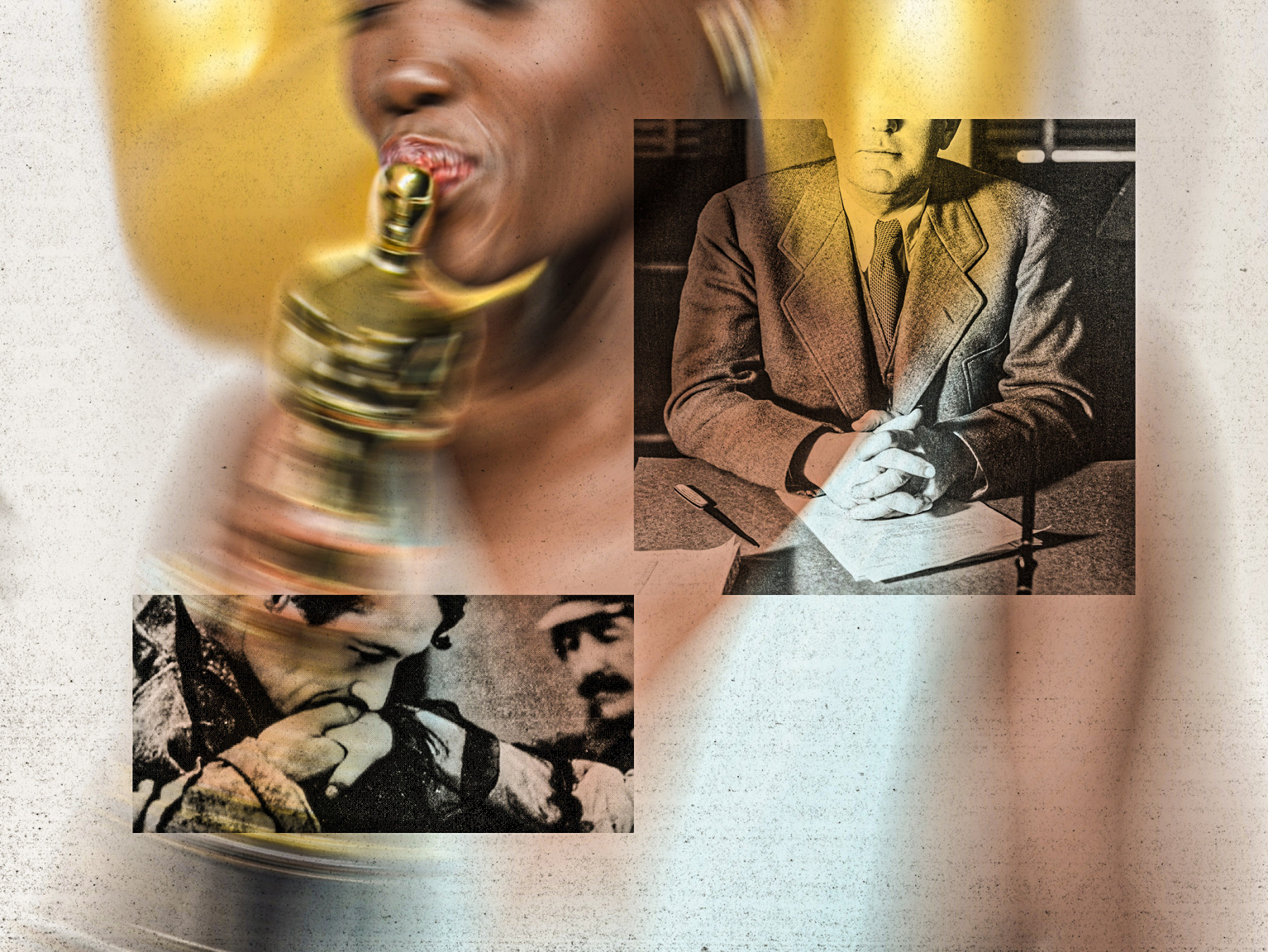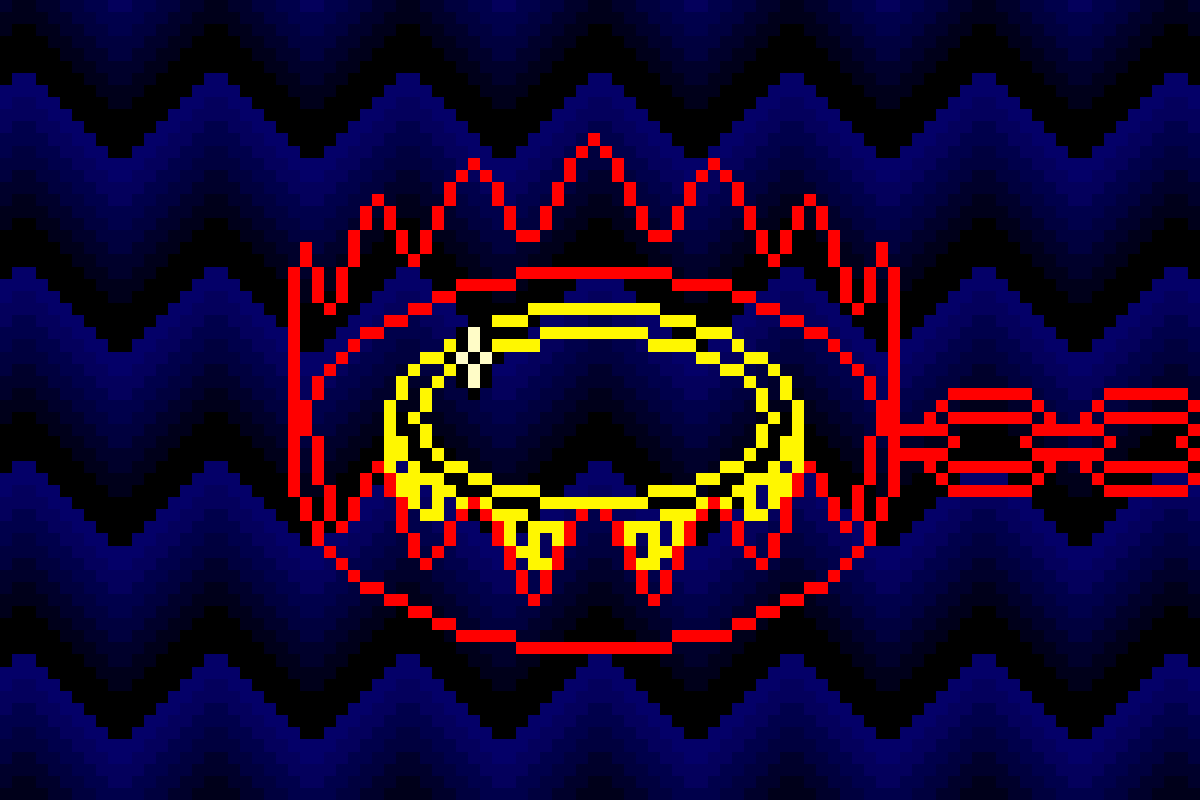If there are two things it makes sense to bet against these days, they are the United States of America and the movies. The faltering status of both institutional bedrocks is well-known. It’s understood they are on the way out; it’s common wisdom, the stuff of countless op-eds online, of conversations at work, over dinner, wherever.
Now A24—which has somehow managed to position itself as the last real movie studio—comes along with writer-director Alex Garland’s Civil War, the ultimate in Hollywood op-ed filmmaking. Here, A24 is betting against the USA, a paradoxical strategy because Hollywood films, at a certain level, are unofficial soft power items used to bolster America as an ever-viable concept.
It’s a cynical move that has paid off at the box office. Civil War, in its third week of release, remains at the top of heap, fighting off challengers from the major studios, which continue to inflict sequels and remakes on an audience that clearly prefers more realistic fare. Now, paramilitary conflict, mass murder of noncombatants, and presidential assassination rule. Godzilla x Kong: The New Empire and Ghostbusters: Frozen Empire can’t compete, maybe because they have “empire” right in their titles. They’re on the wrong side of history. That’s because these unimaginative, unoriginal blockbusters are planned so far in advance. The major studios have no idea what’s going on, anywhere. All they know is they have some intellectual property lying around.
At the same time, Civil War’s success comes from reanimating what had become a too-familiar blockbuster trope, and tropes themselves are not IP. The destruction of the White House amid generalized mayhem is a contemporary Hollywood standard more than ten years old, dating in its twenty-first-century iteration to 2013’s White House Down, where it played on right-wing anti-Obama sentiment by pandering to lizard-brain delight in the apocalyptic destruction of power symbols.
It was kind of a combination of the certain scenes in The Birth of a Nation (1915)—you know the ones—combined with the destruction of Carthage in Cabiria (1914). That’s how old this dreck is—it’s silent-era schtick. Last year, a “mockbuster” (a cheap, dumb version of a pre-existing hit) called DC Down came out. A Tubi Original, DC Down was a made-for-streaming feature so calcified and inert that it seemed to be the genre’s tombstone, a marker in the graveyard of content. This film was more than obscure to the pundit class. No one writing op-eds for a major newspaper would even know it existed.
Garland must have on some level realized that the only money-making political discourse about contemporary America that was still in play in Hollywood genre films was coming from the Purge movies. Those are just as hopeless and violent as Civil War, but they at least identify social dysfunction as a symptom of capitalist immiseration, and they blame right-wing politicians for it.
The Purge movies are, in their way, sick fun; blood-spattered political cartoons. And like White House Down, they started their run in 2013; they are also nothing new. The fifth, and the first to appear after the January 6th attack on the Capitol, was called The Forever Purge. It came out in the summer of 2021, not a good time for theatrical releases. This dispiriting final entry in the series posited a civil war in the US when a fascist paramilitary force turned on the right-wing ruling party that had inspired it, leading to further societal breakdown, anti-Mexican violence, burning cities, and mass migration out of the United States-in other words, the usual. After a shooter killed two people at a showing of The Forever Purge in a California movie theater—one of the victims was a popular TikTok personality—the film was pretty much memory-holed.
Such is the world we live in. To rise above that and make the kind of major statement that would register on the op-ed pages, Garland had to restate the Purge dysfunction, then drain his movie of cartoony fun, and lessen, slightly, the blatant worship of guns. At the same time, he had to appear not to blame either the right or the left for the breakdown of society into chaos.
In other words, he had to make a serious movie, but also a generic movie. Note that the title is simply Civil War, with no The, in true Hollywood fear-of-articles fashion. Things must never get too specific—it crowds the marquee. So in Civil War, it’s just, I don’t know, the Guelphs vs. the Ghibellines, with some ragtag old-school journalists caught in the middle. Who can tell these two sides apart? But there is a well-known common enemy here, the kayfabe wrestling villain of the middlebrow elite: polarization. Conflict itself is the problem Garland has identified, but also the film’s reason for being.
As in action-adventure movies where the villain is a generic evil corporation, a hard-to-pinpoint-on-a-map country with a dictator, or a super-secret government spy agency, in Civil War the evil entity has been reduced to almost zero. There are two sides, yes, but the difference here is that, as Garland has mentioned in interviews, he doesn’t know which side is good or evil. All he knows is that the setting is Failed State, USA.
Civil War follows a group of four journalists who embark on a perilous road trip to Washington, DC. If they get there, they hope to interview the president (Nick Offerman), who is holed up in the White House while the country crumbles. We meet him practicing lines before a televised press conference begins—he’s an actor, a fake.
He’s essentially the Wizard of Oz, and the four journalists on their way to meet him mirror the the four characters on the Yellow Brick Road. Cailee Spaeny, an innocent young photographer, is Dorothy. Kirsten Dunst, the hardened pro, is the heartless Tin Man. Wagner Moura, a posturing, scattered reporter, is the Scarecrow. The final member of the group, an elderly, cautious Black reporter played by Stephen McKinley Henderson, is the Cowardly Lion.
The invisibility of contemporary digital media lets the news media off the hook. If media contributed to the polarization that led to this civil war, this film leaves that out.
Spaeny’s character learns how to “make a good image” from her experiences on the road, and the final image of the film, her photo of the dead president, represents her success. It’s important that the president, like the great and mighty Oz, is a zero. His final words amount to an admission that he’s got nothing to say. His only interest is in his own survival.
The characters’ obsession with getting to the president is like the real media’s obsession with their own prize empty-suit, Donald Trump. Civil War, in a sense, becomes a restatement of the repetitiveness of news media, of all media, in which new content offers the same things over and over in slight variations.
Photojournalism is a ruse here. We see that Spaeny’s character is dedicated to actual 35mm film, even to the point of carrying a negative developing kit with her, which she warms with her body for better results. How analog! Yet how hypocritical in a movie that uses so many computer effects on-screen and whose ad campaign features AI images that don’t even appear in the movie. What does this dedication to real film amount to? These reporters are desperate to get an interview with the president to publish where? Civil War makes a constant appeal to historical journalistic forms but we don’t actually see any forms of media besides photos in freeze-frame on screen. At the same time, the invisibility of contemporary digital media lets the news media off the hook. If media contributed to the polarization that led to this civil war, this film leaves that out.
Meanwhile, professional journalism is a lousier bet today than the USA or the movies. As legacy newspapers and digital upstarts alike lay off thousands of workers, zombified media companies chance their survival on Garland’s bogeyman: polarization itself. Constant coverage of Trump and the high ratings that come with it provided life support to his campaign despite his dismal fundraising. In recent days, images of the growing antiwar protest movement and the brutal police response to it proliferate on social media while news outlets obscure conditions on the ground in Gaza, doing everything they can—just like Garland—to equate the two sides in the conflict.
Garland says the same thing over and over: he doesn’t know which side is just, he’s not taking sides, he’s simply showing polarization in action.
As this is happening, right-wing congressional reps berate college presidents for sound bytes and then descend onto university campuses for photo ops. Like Spaeny’s character in Civil War, someone taught them what makes a “good image” (as opposed to Jean-Luc Godard’s distinction between a “just image” and something that is ”just an image”). Coverage of the actual war in Gaza—the one under protest, in which Israel is leveling cities in a murderous rampage—goes below the fold, to use a journalistic anachronism. As in the cinema, the op-eds overwhelm the actual story.
Garland, who is British—which I think is a telling fact in his neutrality in this American civil war—has given many more interviews about his new film than any director in recent memory has about any other film. In all this coverage, he says the same thing over and over: he doesn’t know which side is just, he’s not taking sides, he’s simply showing polarization in action. That’s it. Again and again he shows up in the very media that’s invisible in his movie, saying the same things. He can’t shut up about how he has nothing to say.
Of course, he is mincing words. In Civil War we see Black and Asian characters brutalized, tortured, and killed more than white ones, and we see the late, unlamented Boogaloo Boys in combat in their aloha shirts while De La Soul’s “Say No Go” plays on the soundtrack—a telling choice as the track is about drug pushers turning crack smokers into zombies, and zombie apocalypse cinema lurks in the background here.
Perhaps it’s a callback to 28 Days Later, the zombie movie Garland wrote twenty-two years ago that also takes place amid apocalyptic societal breakdown. Later in Civil War, the Black woman soldier who will eventually assassinate the president has to kill a Black presidential spokeswoman to get to him, all this to show Garland admits to no real divide, because for him the stakes are low. It’s Hollywood entertainment with a little extra flavor, but not too much. But to quote De La Soul myself (“every word I say should be a hip hop quotable”), for actual Americans, stakes is high. What Civil War leaves us with is a portrait of people “loving to love guns,” which the peace-loving De La Soul rapper Posdnuos brings up on “Stakes Is High,” too.
In the now-infamous scene with Jesse Plemons in his red sunglasses holding his Colt AR-15A3 Tactical Carbine rifle, the film’s one truly terrifying moment of fascist brutality, we see a pile of dead bodies. 35mm film aside, it is impossible to tell if the bodies are all real or semi-computer-generated or what. They are a “bad image.” The shots of those bodies raise questions because they lack graphic clarity and truth value. Comfort with showing piles of fake dead bodies, it seems to me, has become the goal in movies like this; 2022’s remake of All Quiet on the Western Front was another example. This easy digital fakeness is there to get the audience used to it.
The “good image” Spaeny gets at the film’s end, of the dead president with his soldier assassins posing in a thumbs-up gesture of triumph, has been described as reminiscent of the photos of torture from Abu Ghraib, which were not, it should be noted, taken by photojournalists but by the torturers themselves, then leaked by a whistleblower in their Army unit. Spaeny’s photo does not look like one of those to me. The images from Abu Ghraib showed official American violence enacted against foreign prisoners who could not fight back. What Spaeny’s photo reminded me of instead was a different set of infamous trophy photos—the ones of big game hunter Donald Trump Jr. displaying the dead animals he’d killed, posing with his gun.
A. S. Hamrah is the author of The Earth Dies Streaming: Film Writing, 2002-2018 (n+1 Books). He is the film critic for n+1 and writes for a number of other publications, including Harper’s, Bookforum, The Nation, and The New York Review of Books. He is also a documentary film producer. In 2021 he produced the feature film Bunker, directed by Jenny Perlin.



